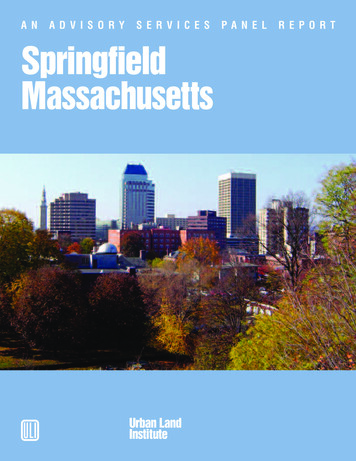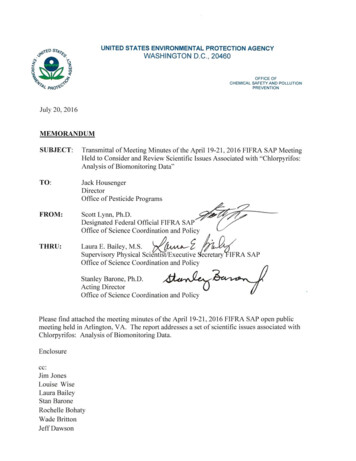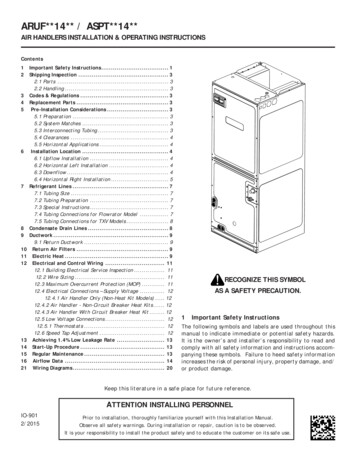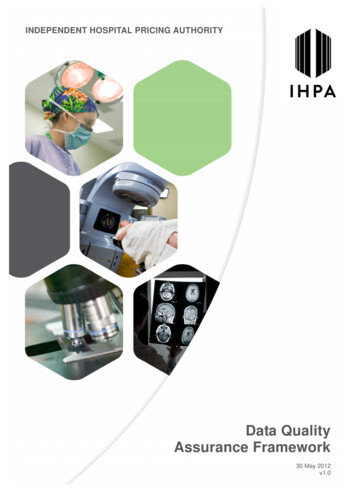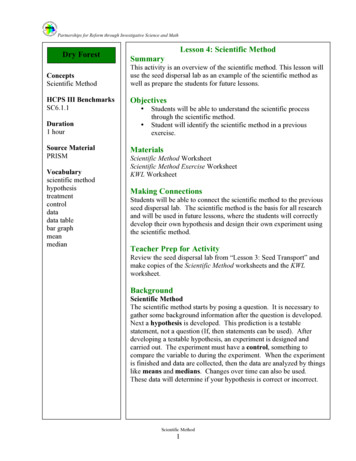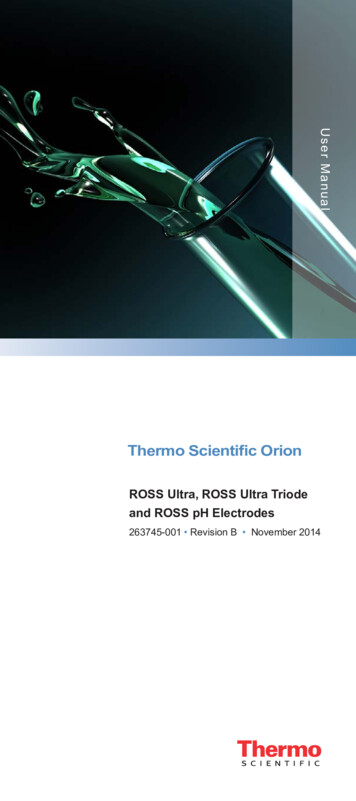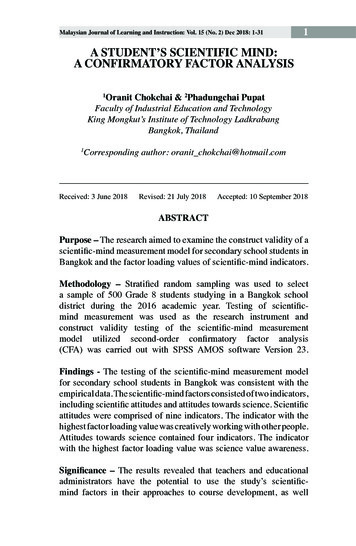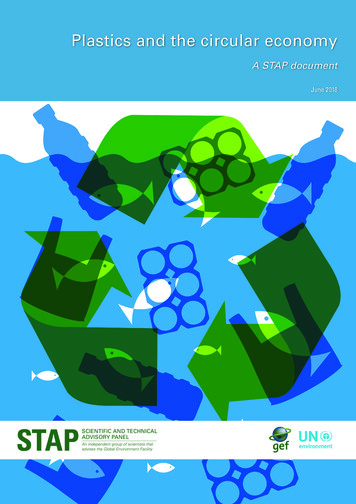
Transcription
Plastics and the circular economyA STAP documentJune 2018SCIENTIFIC AND TECHNICALADVISORY PANELAn independent group of scientists thatadvises the Global Environment Facility
ACKNOWLEDGEMENTThe Scientific and Technical Advisory Panel (STAP) to the Global Environment Facility (GEF) is grateful toall who have contributed to this paper.LEAD AUTHORS:Ricardo Barra, Sunday A. LeonardSTAP CONTRIBUTORS:Christopher Whaley, Rosina BierbaumEXTERNAL REVIEWERS:Patricia Gonzalez (University of Concepcion); Ernesto Hartikainen (Finnish Innovation Fund Sitra); JelmerHoogzaad (Shifting Paradigms), Leah Bunce Karrer (Global Environment Facility); Johanna Lehne (ChathamHouse); Soumen Maity (Development Alternatives), Felix Preston (Chatham House); Martin Scheringer(ETH Zürich); Anil Bruce Sookdeo (Global Environment Facility); Thomas Sterr (Universität Heidelberg);Nilguen Tas (United Nations Industrial Development Organization); Marco Vighi (IMDEA Water Institute –Alcalà de Henares); Melissa Wang (Greenpeace), Zhanyun Wang (Institute of Environmental Engineering,ETH Zurich); Ming-Hung Wong (The Education University of Hong Kong); Vânia Gomes Zuin (FederalUniversity of São Carlos, São Paulo, and University of York).COVER PHOTO:AleksOrel, Shutterstock. Ocean plastic pollution vector illustration. Plastic garbage (bag, bottle) in theocean graphic design. Water waste problem creative concept. Eco problem banner with recycling sign.SUGGESTED CITATION:Barra et al. 2018. Plastics and the circular economy. Scientific and Technical Advisory Panel to the GlobalEnvironment Facility. Washington, DC.COPYRIGHT:This work is shared under a Creative Commons Attribution-Non Commercial-No Derivative Works License.ABOUT STAPThe Scientific and Technical Advisory Panel (STAP) comprises seven expert advisors supported by a Secretariat, who are together responsible for connecting the Global Environment Facility to the most up todate, authoritative and globally representative science. http://www.stapgef.orgABOUT GEFThe Global Environment Facility was established on the eve of the 1992 Rio Earth Summit to help tackleour planet’s most pressing environmental problems. Since then, the GEF has provided over 17.9 billionin grants and mobilized an additional 93.2 billion in co-financing for more than 4500 projects in 170countries. The GEF has become an international partnership of 183 countries, international institutions,civil society organizations, and the private sector to address global environmental issues.http://www.thegef.orgDesign and layout by Phoenix Design Aid A/S, Denmark
Plastics and the circular economyA STAP documentJune 2018
CONTENTSSUMMARY. 31. What is the issue?. 52. What does the science say?. 63. Why is this important to the GEF?. 154. How can the GEF respond?. 16ENDNOTES. 192
SUMMARYThe production of plastics increased by more than twenty-fold between 1964 and 2015, with an annualoutput of 322 million metric tonnes (Mt), and is expected to double by 2035, and almost quadruple by2050. Plastics contribute to economic growth, but their current production and use pattern, on a linearmodel of ‘take, make, use, and dispose’, is a primary driver of natural resource depletion, waste, environmental degradation, climate change, and has adverse human health effects.Conventional plastic production is highly dependent on virgin fossil feedstocks (mainly natural gas and oil)as well as other resources, including water – it takes about 185 litres of water to make a kilogram of plastic.Plastic production uses up to 6% of global oil production, and this is expected to increase to 20% by 2050,when plastic-related greenhouse gas emissions may represent 15% of the global annual carbon budget.Some plastics contain toxic chemical additives, including persistent organic pollutants (POPs), which havebeen linked to health issues such as cancer, mental, reproductive, and developmental diseases. It is difficult to recycle some plastics without perpetuating these chemicals.About 4900 Mt of the estimated 6300 Mt total of plastics ever produced have been discarded either inlandfills or elsewhere in the environment. This is expected to increase to 12,000 Mt by 2050 unless actionis taken. The ocean is estimated to already contain over 150 Mt of plastics; or more than 5 trillion micro(less than 5mm) and macroplastic particles. The amount of oceans plastic could triple by 2025 withoutfurther intervention. By 2050, there will be more plastics, by weight, in the oceans than fish, if the current‘take, make, use, and dispose’ model continues.Plastics stay in the environment for a long time; some take up to 500 years to break down; this causesdamage, harms biodiversity, and depletes the ecosystem services needed to support life. In the marineenvironment, plastics are broken down into tiny pieces (microplastics) which threaten marine biodiversity.Furthermore, microplastics can end up in the food chain, with potentially damaging effects, because theymay accumulate high concentrations of POPs and other toxic chemicals.Microplastics are an emerging source of soil and freshwater pollution. The contamination of tap andbottled water by microplastics is already widespread, and the World Health Organization is assessing thepossible effects on human health.The continued rapid growth in the production and use of plastics will have a severe and deleterious effecton the GEF’s ability to deliver its objectives in the following areas:i. Chemicals and waste: some POPs are used as chemical additives in some plastics, and dioxins andfurans are byproducts of polyvinyl chloride (PVC) manufacture.ii. Climate change mitigation: producing plastics using fossil fuels is an important source of greenhouse gas emissions, as is the open burning and incineration of plastic wastes. Greenhouse gasemissions from plastics were estimated to be 390 million tonnes of CO2 in 2012.iii. International waters: plastics pollution is prevalent in all oceans globally.Summary3
iv. Biodiversity: plastics pollution is the second most significant threat to the future of coral reefs, after climatechange. The impact of plastic on marine species, including entanglement and ingestion by turtles, fishand mammals, is well documented. Many of the chemicals additives used in plastics have proven adverseeffects on fisheries and their habitats.v. Land degradation and food systems: the emerging threat from microplastics to terrestrial ecosystems,especially agricultural soils could lead to further land degradation affecting food production, includingthrough microplastics contamination of food products.The circular economy is an alternative to the current linear, make, use, dispose, economy model, which aimsto keep resources in use for as long as possible, to extract the maximum value from them whilst in use, andto recover and regenerate products and materials at the end of their service life. It offers an opportunity tominimise the negative impacts of plastics while maximising the benefits from plastics and their products, andproviding environmental, economic, and societal benefits. Circular economy solutions for plastics include: producing plastics from alternative non-fossil fuel feedstocks; using plastic wastes as a resource; redesigning plasticmanufacturing processes and products to enhance longevity, reusability and waste prevention; collaborationbetween businesses and consumers to encourage recycling and increase the value of plastic products; encouraging sustainable business models which promote plastic products as services, and encourage sharing and leasing;developing robust information platforms to aid circular solutions; and adopting fiscal and regulatory measures tosupport the circular economy.Circular economy solutions will help in ‘closing the material loop’, that is to minimise waste and to keep materialsin the economy and out of landfills and incinerators, but the circular economy will not completely solve the globalplastic problem. An all-encompassing solution should seek to ‘slow the material loop’, that is to reduce demandand produce only essential plastic products, including through discouraging non-essential production and use ofplastics, and promoting the use of renewable and recyclable alternatives to plastics.The GEF can play a significant role in promoting a transition to the circular economy in the plastics sector. Inthe short term, the GEF should mainstream circular economy concepts into its overall strategy, for example, ascriteria for priority setting and decision making; invest in projects that promote circular concepts in the plasticssector to deliver global environmental benefits; help to create an enabling environment to overcome barriers andpromote the adoption and implementation of the circular economy in the plastics sector; and incorporate plasticpollution mitigation into the Integrated Approach Pilot (IAP) for sustainable cities.Looking into the future, the GEF should consider: supporting the development of circular economy indicatorsrelevant to its work; collaborating with, and supporting partnerships and projects aimed at tackling the globalplastic challenge, and facilitating and supporting innovation and applied research related to implementing thecircular economy into the plastics sector.4Summary
1. WHAT IS THE ISSUE?Plastics are one of the world’s greatest industrial innovations, but the sheer scale of their production and poordisposal practices are resulting in growing adverse effects on human health and the environment, including onclimate change, marine pollution, biodiversity, and chemical contamination, which require urgent action. Plastics are used in many sectors such as packaging, construction, automotive manufacture, furniture, toys, shoes,household appliances, electrical and electronic goods, and agriculture. This wide demand has caused plasticsproduction to explode globally, now outgrowing most man-made materials1 . Plastic production increased bymore than twenty-fold between 1964 and 2015, with annual output reaching 322 million metric tonnes (Mt)2. Asecond analysis indicates that annual global plastics production rose from 2 Mt to 380 Mt between 1950 and20153. Future plastics production is projected to double by 2035 and almost quadruple by 20504 .Historically, plastics were mostly produced in Europe and the United States. However, this has recently shifted toAsia. China is now the leading producer with 28% of global production in 2015, while the rest of Asia, includingJapan, produces 21% (Figure 1)5, i.e. nearly half the global production in 2015.Plastics contribute to economic growth6 , but their current production and use pattern, on a linear model of ‘take,make, use, and dispose’, is a primary driver of natural resource depletion, waste, environmental degradation,climate change, and has adverse human health effects. Globally, it is estimated that only 9% of the 6300 Mt ofplastic waste generated between 1950 and 2015 was recycled7 . India has probably the highest plastic recyclingrate with estimates ranging from 47 to 60%8 . In the EU, only approximately 30% of 25 Mt of post-consumer plastic waste was recycled in 20149 ; China had a recycling rate of 22% in 201310 ; while only 9.5% of plastics enteringthe US municipal solid waste stream were recycled in 201411 . In Latin America and the Caribbean, recycling ratesare also low12 .Commonwealth ofIndependent States3%Europe18%USA, Canadaand Mexico19%Middle Eastand Africa7%ChinaRest of Asia21%28%Latin America4%Figure 1. Global distribution of plastics production (based on estimates in endnote 5)Plastics and the circular economy5
2. WHAT DOES THE SCIENCE SAY?2.1. Negative impacts of plasticsThe production, use and disposal of plastics are associated with significant adverse externalities in the environment, economy and society, at different stages of their life cycle (Figure 2). These include:Impacts of plastics production and use C onventional plastic production is highly dependent on virgin fossil feedstocks (mainly natural gas andoil) as well as other resources, including water – it takes about 185 litres of water to make a kilogram ofplastic13. Plastics production consumes up to 6% of global oil production and is projected to increase to 20%by 2050 if current consumption patterns persist14 . Plastics are therefore a major contributor to greenhousegas emissions: CO2 emissions from the extraction and processing of fossil fuel as plastics feedstocks; andthe combustion of waste plastics, emitting 390 million tonnes of CO2 in 201215 . On current trends, emissionsfrom the global plastics sector are projected to increase from 1% in 2014 to 15% of the global annual carbonbudget by 2050 (Figure 2)16 . Some plastics contain toxic chemical additives, which are used as plasticisers, softeners or flame retardants.These chemicals include some persistent organic pollutants (POPs)17 such as short-chain chlorinated paraffins (SCCP), polychlorinated biphenyls (PCBs), polybromodiphenyl (PBDEs including tetrabromodiphenylether (tetraBDE), pentabromodiphenyl ether (pentaDBE), octabromodiphenyl ether (octaBDE) and decabromodiphenyl ether (decaBDE)), as well as endocrine disruptors such as bisphenol A (BPA) and phthalate18 .Chlorinated dioxins (polychlorinated dibenzo-p-dioxins), chlorinated furans (polychlorinated dibenzofurans),PCBs (polychlorinated biphenyls), and hexachlorobenzene (HCB) are also byproducts of the manufacture ofpolyvinyl chloride (PVC)19 . These chemicals have been linked to health issues such as cancer, mental, reproductive, and developmental diseases20 .Impacts from disposal and post-disposal I t is difficult to recycle some plastics without perpetuating the harmful chemicals they contain. Furthermore, some plastics are very thin, for example, plastic bags and films, or multi-layered, for example, foodpackaging, making them difficult and expensive to recycle21 . The lack of universally agreed standards andadequate information about the content and properties of some plastics also discourage recycling. It is estimated that between USD 80 and 120 billion worth of material value is lost to the global economy annuallybecause of the low recycling rate of most plastic packaging22 . Around 4900 Mt of the estimated 6300 Mt total of plastics ever produced have been discarded eitherin landfills or elsewhere in the environment. This is expected to increase to 12,000 Mt by 2050 unlessaction is taken23. The ocean is estimated to already contain over 150 Mt of plastics24; or more than5 trillion micro (less than 5mm) and macroplastic particles25. Much of this land-based discharge to theoceans originates in five Asian countries: China, Indonesia, the Philippines, Thailand, and Vietnam26, with tenrivers across Asia and Africa (Indus, Ganges, Amur, Mekong, Pearl, Hai he, Yellow, Yangtze, Nile, and Niger)responsible for transporting 88 – 95% of the global load into the sea27. The top 20 polluting rivers, mainly inAsia, release 67% of all plastic waste into the oceans28. The amount of oceans plastic could triple by 2025without further intervention29. By 2050, there will be more plastics, by weight, in the oceans than fish,if the current ‘take, make, use, and dispose’ model continues30. Single-use plastics contribute significantlyto this leakage. About 330 billion single-use plastic carrier bags are produced annually and often used forjust a few hours before being discarded into the environment31 . Single-use plastics make up about half of6Plastics and the circular economy
beach litters in all four European Regional Seas Areas – the Mediterranean, North Atlantic, Baltic, and theBlack Sea32 and they can now be found even in the deepest world’s ocean trench33 . Plastics stay in the environment for a long time; some take up to 500 years to break down; this causesdamage, harms biodiversity, and depletes the ecosystem services needed to support life. After climatechange, plastic is the biggest threat to the future of coral reefs: it increases the likelihood of diseaseoutbreaks by more than 20 times, threatening marine habitats that provide food, coastal protection, income,and cultural benefits to more than 275 million people34 . I n the marine environment, plastics are broken down into tiny pieces (microplastics35) which threatenmarine biodiversity36. Furthermore, microplastics can end up in the food chain, with potentially damagingeffects on human health, because they may also accumulate high concentrations of POPs and other toxicchemicals37, and potentially serve as a pathway for their transfer to aquatic organisms38, and consequentlyhuman beings39. There have been calls for microplastics to be considered as POPs40 because of their pervasive and persistent nature41. There is, however, currently no scientific evidence that microplastics are directlyharmful to human health. N ew knowledge suggests that microplastics are an emerging source of soil pollution42. The impacts ofmicroplastics in soils, sediments and freshwater could have a long-term damaging effect on terrestrial ecosystems globally through adverse effects on organisms, such as soil-dwelling invertebrates and fungi, neededfor important ecosystem services and functions43. Up to 895 microplastic particles per kilogram have beenfound in organic fertilisers used in agricultural soils44. Up to 730,000 tonnes of microplastics are transferredevery year to agricultural lands in Europe and North America from urban sewage sludges used as farm manure, with potentially direct effects on soil ecosystems, crops and livestock or through the presence of toxicchemicals45. Microplastics are an emerging freshwater contaminant which may degrade water quality and consequently affect water availability and harm freshwater fauna46. The contamination of tap and bottled waterby microplastics is already widespread47 , and the World Health Organization is assessing the possible effectson human health48 . A significant proportion of disposed plastic ends up in municipal solid waste (MSW)49. In many developing countries50, inadequate or informal waste management systems mean that waste is usually burned inopen dumps or household backyards, including in cities linked to the top ten rivers which transport plasticwaste to the sea. In other places, MSW is incinerated. The open burning or incineration of plastics hasthree negative effects: it releases CO2 and black carbon – two very potent climate-changing substances51;burning plastics, especially containing chlorinated and brominated additives, is a significant source of air pollution, including the emission of unintended POPs (uPOPs) such as chlorinated and brominated dioxins, furans, and PCBs52; and burning plastic poses severe threats to plant, animal and human health, because toxicparticulates can easily settle on crops or in waterways, degrading water quality and entering the food chain53 . I n 2014, UN Environment estimated the natural capital cost of plastics, from environmental degradation,climate change and health, to be about USD 75 billion annually with 75% of these environmental costsoccurring at the manufacturing stage54. A more recent analysis55 indicates the environmental cost could beup to USD 139 billion56.Plastics and the circular economy7
Recent EstimatesBusiness as Usual ProjectionsProduction and UseTonnes of plasticproduced311-380 Mt in 2015a1244-1520 Mt by 2050bPlastics share of global oiland gas consumptionc6% in 201420% by 2050Plastics share of globalcarbon budgetc1% in 201415% by 2050Disposal and Post-disposalAmount of plastic wastegenerateddApprox. 5,800 Mt fromprimary plastics or 6,300Mt when waste fromsecondary (recycled)plastics are included.Cumulative from 1950 to2015Approx. 26,000 Mt from primary plastics or 33,000 Mtwhen waste from secondary (recycled) plastics areincluded. By 20504900 Mt in 201512,000 Mt by 2050Over 150 Mt in 2015Over 450 Mt by 2025Plastics in landfill or in theenvironmentdPlastics in oceansdRatio of plastics to fish inthe oceans (by weight)c::1:5 in 20141:1 by 2050a this is a range of estimates in Plastic Europe, 2016; WEF, EMF, McKinsey & Company, 2016; and Geyer et al. 2017b estimated by applying the 2050 projection in WEF, EMF, McKinsey & Company, 2016 to the range of 2015 estimates in Plastic Europe, 2016; WEF,EMF, McKinsey & Company, 2016; and Geyer et al. 2017c see WEF, EMF, McKinsey & Company, 2016d see Geyer et al. 2017e based on estimates in Ocean Conservancy, 2015 and extrapolation of this estimate using 2025 projection by Jambeck et al. 2015.Figure 2: A summary of current and future impacts of continuing linear production and use of plastics8Plastics and the circular economy
2.2. The circular economyThe circular economy is an alternative to the current linear, make, use, dispose, economy model, which aimsto keep resources in use for as long as possible, to extract the maximum value from them whilst in use, and torecover and regenerate products and materials at the end of their service life57. The circular economy58 promotesa production and consumption model that is restorative and regenerative by design59. It is designed to ensurethat the value of products, materials, and resources is maintained in the economy at the highest utility and value,for as long as possible, while minimising waste generation, by designing out60 waste and hazardous materials.The circular economy applies both to biological and technical61 materials. It embraces systems thinking andinnovation, to ensure the continuous flow of materials through a ‘value circle’62, with manufacturers, consumers,businesses and government each playing a significant role63 .The World Economic Forum reported that material (technical and biological) cost savings of up to 1 trillion peryear could be achieved by 2025 by implementing the circular economy worldwide64. And the World BusinessCouncil for Sustainable Development (WBCSD) “CEO Guide to the Circular Economy” indicates that the circulareconomy could help unlock USD 4.5 trillion of business opportunities while helping to fulfil the Paris Agreement65. Implementing the circular economy across the energy, built environment, transport, and food sectors inEurope could reduce carbon emissions by 83% by 2050 compared to 2012 levels66. A study by the Club of Romealso indicates that transitioning to a circular economy across various economic sectors in five European countries(Finland, France, the Netherlands, Spain and Sweden) by 2030 could lead to a two-thirds reduction in carbonemissions, lower business costs, and create up to 1.2 million jobs67 . While studies on developing countries arescarce, UNDP reported that circular economy strategies could help the Lao DPR achieve its climate mitigationtargets, while also developing local industries, reducing dependency on resource rents, imported materials andproducts, thus helping to reduce poverty68 .2.3. Circular economy solutions for the plastic sectorThe Ellen MacArthur Foundation summarised the goals for a circular economy in the plastics sector (Figure 3)as follows: improve the economic viability of recycling and reuse of plastics; halt the leakage of plastics into theenvironment, especially waterways and oceans; and decouple plastics production from fossil-fuel feedstocks,while embracing renewable feedstocks69 .Recent science and innovation highlights examples of how these goals might be achieved:i) Produce plastics from alternative feedstocksExamples of alternative feedstocks include greenhouse gas such as CO2 and methane70, bio-based sources suchas oils, starch, and cellulose71, as well as naturally occurring biopolymers, sewage sludge and food products72.Some plastics can be produced using benign and biodegradable materials73. And eco-friendly alternativeflame retardants have been developed which could eliminate the use of some hazardous chemicals in plasticsmanufacture74.Plastics and the circular economy9
Energy recoveryProduction of onlyLeakessential plasticsConsumer use basedusing renewableon sustainableresourcesFossil fuelagesbusiness modelsbaseRedesignedplasticproduction andRenewableproductsalternativesourcesReuse throughmodels such asrefurbishing, sharing,leasing, redistributionand symbiosisRecycling includingthrough remanufacturing,chemical recycling, organicrecycling, and conversionto new productsFigure 3: Circular economy solutions in the plastics sectorTo mitigate the adverse effects of the current mainly linear plastics production and use model, plasticsproduction from renewable sources needs to increase to reduce dependence on fossil fuels significantly. Production processes and products should be redesigned to improve longevity, reusability, recyclability, as wellas to prevent waste and chemical pollution. Sustainable business models that promote products as services,facilitate sharing and leasing of plastic products, and increase reuse should also be encouraged. Plastics atthe end of life should increasingly be recycled into new products to significantly reduce the volume of plasticsleaking into the environment.ii) Use plastic waste as a resourceThe capture and recovery of plastic waste for remanufacturing into new value products has been widely demonstrated, for example, for making bricks and composites75, in road construction76, for furniture, as well as formaking clothes and footwear77. Plastic waste has also been converted to liquid fuel78 and has been burned asfuel in a waste-to-energy cycle79, though there are downsides to the latter80. Through chemical recycling81, thepetrochemical components of plastic polymers can also be recovered for use in producing new plastics, or for10Plastics and the circular economy
the production of other chemicals, or as an alternative fuel82. For example, a recent study successfully developedplastics that can be chemically recycled and reused infinitely83. Studies84 also suggest that polyethylene plastic,a significant proportion of manufactured plastics globally, can be broken down by bacteria and caterpillars,highlighting opportunities for biobased recycling of waste plastics85 .(iii) Redesign plastics manufacturing processes and products to improve longevity, reusability and wasteprevention, by incorporating after-use, asset recovery, and waste and pollution prevention into the designfrom the outset86This means adopting a life-cycle approach87 including: cleaner production; discouraging single- and other avoidable plastics use; as well as designing products for appropriate lifetimes, extended use, and for ease of separation,repair, upgrade and recycling88; eliminating toxic substances; and preventing the release of microplastics into theenvironment by redesigning products. For example, designing clothes and tires to reduce wear and tear, andeliminating, or using alternatives to, microplastics in personal care products such as toothpaste and shampoo. Afurther example, of redesign is the bulk delivery of cleaning and personal care products supplied with refillableplastic containers, thereby eliminating single-use bottles89. Existing applications of this model include Replenishbottles, Petainer packaging, and Splosh90. Another example is reusable beverage bottles as an alternative tosingle-use bottles, for example, a returnable bottle system and refillable bottles, which can lower material costsand reduce greenhouse gas emissions91.(iv) Increase collaboration between businesses and consumers to increase awareness of the need for, andbenefits of, a shift from non-essential plastic use and a throw-away culture, to encourage recycling, and toincrease the value of plastic products, for example, by using by-products from one industry as a raw materialfor another92 (industrial symbiosis). Several analyses93 have highlighted the climate and environmental benefitsfrom plastic waste recycling through industrial symbiosis. Households can be included in the symbiosis process94,by strengthening waste collection systems and by creating innovative and effective take-back programs95. Analysis of urban-industrial symbiosis (exchanging resources between residential and industrial areas) in a Chinesecity96 indicated that producing energy from plastic waste97 led to an annual reduction in CO2 emissions of 78,000tonnes while avoiding the discharge of 25,000 tonnes of waste plastics98 a year into the environment99.(v) Embrace sustainable business models which promote products as services and encourage the sharingand leasing of plastic productsThis would optimise product utilisation and increase revenue while decreasing the volume of manufacturedgoods. An example of this is the leasing of water dispensers and refillable plastic bottles to households andoffices. Another example is the Lego’s Pley system where consumers rent and return Lego sets rather than buythem100.(vi) Develop robust information platforms which provide data on the composition of plastic products, trackthe movement of plastic resources within the economy, support cross-value chain dialogue and the exchangeof knowledge, and build on experiences gained through existing global institutional networks. An example of aglobal network is the RECPnet (Resource Efficient and Cleaner Production Network) that promotes resource-efficient cleaner production and
environment, plastics are broken down into tiny pieces (microplastics) which threaten marine biodiversity. Furthermore, microplastics can end up in the food chain, with potentially damaging effects, because t
